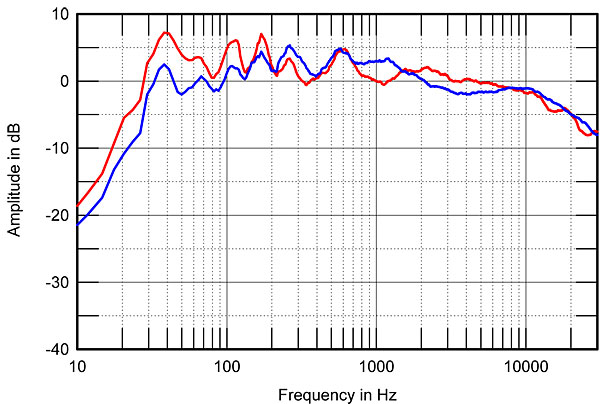| Columns Retired Columns & Blogs |
The Fifth Element #64 Vivid Measurements
Sidebar 2: Vivid Measurements
As John Marks mentions, as I was visiting him to both check out his new listening room and listen to the two pairs of Vivid loudspeakers, I took the opportunity to measure each speaker's spatially averaged response in his room. I perform this measurement by averaging twenty 1/6-octave–smoothed responses taken, for each speaker individually, in a rectangular grid measuring 36" by 18" and centered on the positions of the listener's ears in the listening chair. (I used an Earthworks QTC-40 omni microphone and a Metric Halo ULN-2 FireWire audio interface, in conjunction with SMUGSoftware's FuzzMeasure 2.0 running on my Apple laptop.) In a room of typical size, this measurement integrates the speaker's power response with its direct-arrival sound to give a graph that tends to correlate quite well with its perceived balance.
Both pairs of speakers were placed in the same positions in John's room (see photo). The results are shown in fig.1, the red trace showing the spatially averaged response of the B-1, the blue trace that of the V-1.5. I didn't calibrate the absolute sound pressure levels in this graph, and so have arbitrarily matched the levels at 1.5kHz.

Fig.1 Spatially averaged, 1/6-octave response in JM's listening room of Vivid B-1 (red) and Vivid V-1.5 (blue).
Both speakers roll down gently in the treble, which is the effect of both the limited dispersion of the tweeter above 10kHz and the increased absorption of the room furnishings in this region. However, the V-1.5 can be seen to put out a touch less mid-treble energy than the B-1. JM thought the B-1 revealed a slight midrange nasality in the V-15's sound; I suspect that this is connected with the slight step in the V-15's room response just above 1kHz, though the B-1's response is slightly less smooth overall. Both speakers have a small peak at 600Hz, though this may be a room effect that has not been minimized by the spatial averaging.
In the bass, the smaller V-1.5 has both less low-frequency extension and less mid- and upper-bass energy than the B-1, but both speakers benefit from some reinforcement from the lowest-frequency mode in John's room, at around 38Hz. Conversely, the V-1.5 doesn't excite the resonances in JM's room as much as the B-1 does.
I was as impressed as John had been by the V-1.5, but after some extended listening, it was clear that the more expensive B-1 was indeed the better speaker: It sounded more neutral, its treble was better matched to the room, and its bass extension was more satisfying. While both pairs of Vivids were imaging champs, the B-1s' soundstaging was some of the best I have heard, with superlatively solid and stable images. And this was with the relatively modestly priced Ayre CD player and integrated amplifier. The Indian food at Pawtucket's Rasoi restaurant, by the way, was also as good as it was unassuming. But when it comes to Ayre's Irrational, But Efficacious! System Enhancement CD, I'd much rather live in a world where this didn't have any effect. I have since been sent a copy of this CD; I daren't get it out of the shrinkwrap.—John Atkinson
- Log in or register to post comments




































